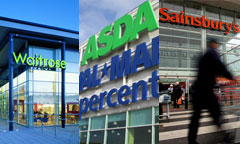 The City analysts cannot make up their minds as to whether the supermarkets’ investment in convenience stores is a good thing or not. The FT in a Monday analysis piece suggests that “Grocers count cost of smaller outlets”. It is a clever headline. Obviously they are managing their costs. But also they are measuring the impact on their bottom line.
The City analysts cannot make up their minds as to whether the supermarkets’ investment in convenience stores is a good thing or not. The FT in a Monday analysis piece suggests that “Grocers count cost of smaller outlets”. It is a clever headline. Obviously they are managing their costs. But also they are measuring the impact on their bottom line.
There are several issues. If you sell 399 chicken dinners and have one left over, the cost model is very different from a shop where you sell nine chicken dinners and have one left over. If your 60,000 square foot hypermarket is sited where land is cheap and rates low, the cost of storing those dinners will be cheaper than in a 3,000 square foot store in a city centre.
How do the grocers try to manage the costs?
- By clustering c-stores close together so you only need one truck to do deliveries
- By tailoring what the stores offer to local demand and getting the stock levels correct
- By trying to persuade shoppers to buy premium products.
“If people are going to come in and buy steak and a bottle of wine, it completely changes the economics,” Miles Foster, who is heading Morrisons’ c-store trial, told the FT. However, it is clear that the supermarkets are struggling with finding a competitive advantage against the wholesaler/cash and carry to symbol group/independent supply chain for local stores.
Independent retailers cannot be complacent but they may be encouraged. The big box approach works for superstores in part because the cost of travelling to the stores is taken by the shopper – both in time and through the cost of fuel. Moving the shop closer to the shopper means the supermarkets are taking over a bigger share of this cost and so far they can’t make the sums add up.





Comments
This article doesn't have any comments yet, be the first!